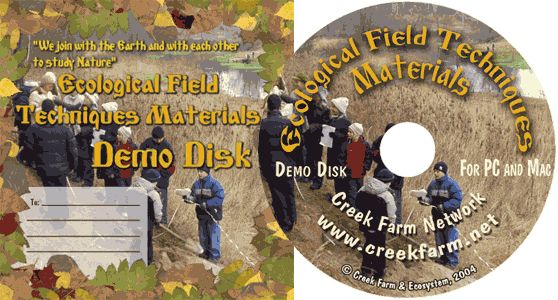|
| Our Field Ecology Center published more than
180 methodical materials for nature studies. Some of them are in English: |
|
|
|
Study of Forest Invertebrates (Part 2: Grass Layer, Tree Crowns and
Air)
© Alexsander S. Bogolyubov,
Russia, 2001
© Michael J. Brody, USA,
2003
 This lesson continues the study of forest
invertebrate studies and includes a description of equipment for field studies as well as
a description of techniques for collection and census of invertebrates inhabiting grass,
tree crowns and shrubs, as well as flying invertebrates. This lesson continues the study of forest
invertebrate studies and includes a description of equipment for field studies as well as
a description of techniques for collection and census of invertebrates inhabiting grass,
tree crowns and shrubs, as well as flying invertebrates.
This field study has instructional video
featuring real students conducting the ecological field techniques in nature. Each video
illustrates the primary instructional outcomes and the major steps in accomplishing the
task including reporting the results.
Introduction
This field study continues the study of invertebrate animals found in different
environments. The first part of the lesson describes the procedures for collecting and
censusing insects in the forest litter and wood. Students will learn procedures for
collection and censusing of invertebrates inhabiting the grass layer, and tree crowns, as
well as flying invertebrates. The introduction of the field study is devoted to general
rules of entomological studies and general provisions for procedures of collection and
census of invertebrates found in the previous lesson devoted to this topic.
Organization of studies
First, students will learn the different types of habitats of invertebrates and the
corresponding ecological groups. The following habitats are found within a forest:
soil, forest litter, grass layer, wood (trunks of trees and stumps), crowns of shrubs and
trees and the surrounding air environment. Field studies are organized in accordance with
this structure; each of these habitats is investigated consecutively.
When preparing for this activity, students should be reminded of the general rules of
invertebrate collection, as well as the main techniques and instruments for their
collection. We recommend discussing in more detail the ecological groups of invertebrates
found in the habitats under study Ц grass layer, tree crowns and air environment, as
well as techniques and instruments of animal collection in these environments.
Practical studies should begin with a lesson devoted to mastering techniques of
censusing and collection of invertebrates in grass, tree crowns and in air. The whole
group works together during this introductory field session to conduct УdemonstrativeФ
censusing following each technique in one of the typical biotopes in the immediate
vicinity of the school or field studies center.
The main part of the field research is organized in the following way. The group
of students is divided into working teams of 2-3 persons and each team is given an
assignment Ц to study a different biotope within the area under study. When studying a
grass layer, habitats can include different types of meadows (for example, a dry meadow at
watershed sites and a floodplain meadow), clearings in a forest, agricultural lands, etc.
While studying tree crowns they can include crowns of different tree and shrub species or
crowns of the same plant species growing in different plant associations, or biotopes. As
for the air environment, the diversity of habitats of flying insects is rather high. It is
possible to compare forests and open biotopes, natural and urban landscapes, areas at
different distances away from a water body, etc.
In regard to techniques for catching and censusing flying invertebrates, it is
possible to limit students to two simple methods: a relative route (visual) count
of day butterflies and a night census with the help of a light trap (see below).
Other techniques for catching flying invertebrates can be used at the discretion of the
teacher based on the availability of Уstudent powerФ resources and time.
One census according to each of the techniques is carried out in each of the biotopes
found within the area under study. As in the first part of the field study on forest
invertebrates, it is possible to limit the analysis to the following parameters:
- Total taxonomic lists of invertebrates found in different habitats;
- Diversity of species (number of species) in different habitats ...
This was only the first page from the manual and its full version you can see in the
Ecological Field Studies Techniques Video 4CD Set:
It is possible to purchase the complete set of 40 seasonal Ecological Field
Studies Techniques Video (in mpg format) in an attractive 4 compact disk set.
These compact disks are compatible with Mac and PC computers.
The videos are suitable for individual student or whole class instruction. To purchase the complete 4CD set
write to ecosystema1994@yandex.ru in a free form.

Ecological Field Studies Demo Disk:
We also have a free and interesting demonstration disk that explains our ecological field studies approach.
The demo disk has short excerpts from all the seasonal field study videos as well as sample text from all the teacher manuals.
The disk has an entertaining automatic walk through which describes the field study approach and explains how field studies meet education standards.
You can also download the Demo Disc from ecosystema.ru/eng/eftm/CD_Demo.iso.
This is a virtual hybrid (for PC and Mac computers) CD-ROM image (one 563 Mb file "CD_Demo.iso").
You can write this image to the CD and use it in your computer in ordinary way.
You also can use emulator software of virtual CD-ROM drive to play the disk directly from your hard disk.

|







